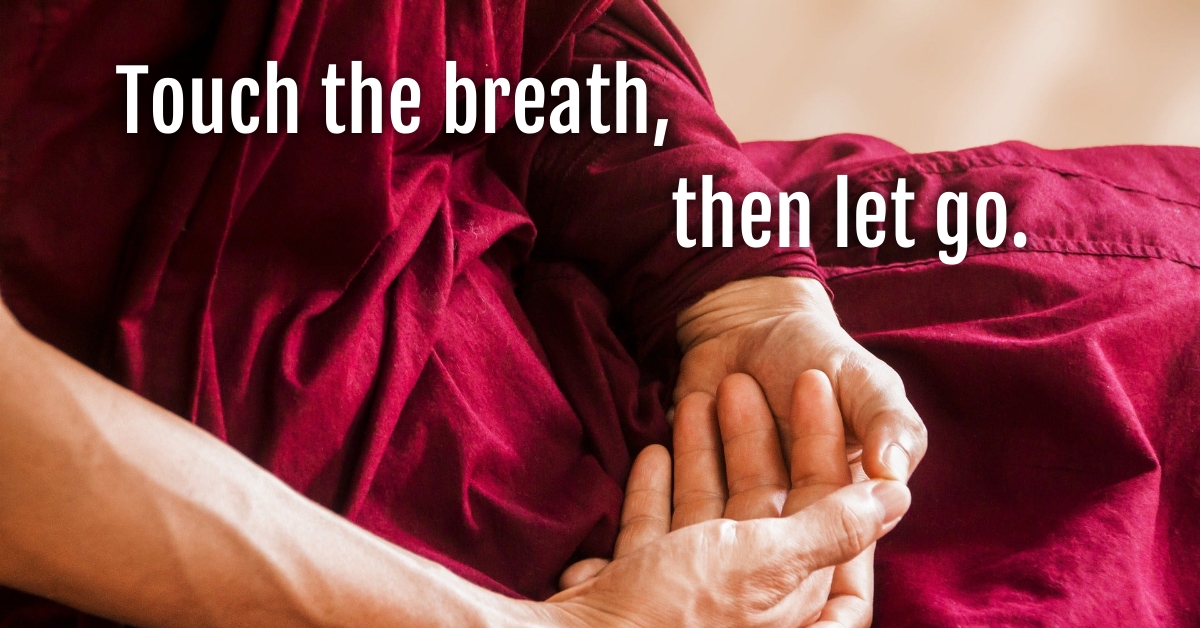Recently, I was asked about a new instruction received from a monk of a Tibetan Buddhist tradition in relation to meditation on the breath. The instruction is to just touch the breath and let go.
In my book, I talk about not pushing or pulling, and I emphasise this quite a lot. You nudge yourself into the meditation and then allow the meditation to take you. For the breath meditation, you bring their attention to the breath; “you make contact with the breath” is the way I sometimes say it.
Once you are aware of the breath, you can stop any pushing or pulling. Nor do you hold on to your contact with the breath. Lama Allen suggested (who received this instruction from his Lama) that on the in-breath, to focus on the breath and on the out-breath, to let go of focusing.
Can you be aware of something like the breath without focusing on it? The word focus, for most people, has a similar definition to the word concentration. I dropped the word concentration, because it creates the wrong attitude. But if we’re just substituting that word for the word focus and still using the same intensity, then we’re still building the conditions that will get in the way of the results we want from meditation.
Focusing, for most people, is a push or a pull. So letting go is a remedy for those people who habitually control, push and pull. To just let go and allow their awareness to be where it is.

For most people in the West (especially driven/ambitious people), that’s not an easy thing to do – or not do. We’re so used to doing something.
Letting go is not the same as pushing away, pulling away your attention, or ignoring. What the Buddhist monks mean regarding meditation, is simply to let go of any force behind the focus.
Eventually, a magnetic pull, a stickiness, comes into play (this is a force produced in Engrossed Attention (EA)* meditation, I call the Principle of Gravity**). Your awareness sticks with the object without you controlling, pushing or pulling. It stays there, like a trained dog, “stay!” Which is what we want.
For most of us, at the beginning, our awareness will drift. As you get into the meditation, especially after three rounds of 10 breaths, you may notice that your awareness stays with the breath a little longer. When the Gravity Principle kicks-in (sometimes it’s quick and other times it isn’t), you do not need to focus anymore; your awareness is steady. Before the Principle of Gravity keeps your awareness steady, you have to keep bringing your awareness back to the breath (without holding it in place). Once steady, you still need to bring your awareness back but less often.
* Engrossed Attention (EA) is a term I explain in the book, “There Are Only 7 Ways to Meditate”, but other terms (translations from the ancient Sanskrit or Pali languages) are concentration, or focussed meditation.
** The Principle of Gravity is explained in the upcoming book, “7 Secret Codes of Meditation” (join my newsletter for the chance to get a free copy of the new book – or both).
If you have any questions or comments, download my app and find the Q&A section, where you can message me your questions, or reply to my free newsletter.

About the Author
Colin (Q.C. Ellis) has been on meditation retreats in silence and solitude for longer than some monks. He has been studying meditation for over 23 years.
Known as a meditation maverick, he teaches methods to awaken your body’s natural restorative abilities and fire up your inbuilt happiness.
Keeping it real and grounded in personal experience, he is a Transformation Coach, Meditation Teacher, and founder of IntrAnaut™ Academy.
In person, Colin is approachable and would love to hear from you. For ways to connect, click HERE – ColinEllis.info
For additional resources, download his FREE mobile app – intrAnaut Meditation
More information on his book, There Are Only 7 Ways to Meditate: Make Your Meditation Amazing
